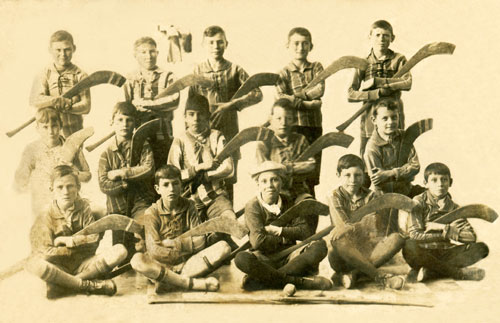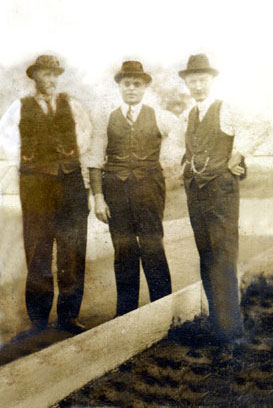|

The Fahy Boys, c. 1926
(Hurling Club collection)
|
Generally
those that played hurling in the early days were urban
middle-class workers who had settled in the western
districts of the city of Buenos Aires, principally Villa
Devoto, Belgrano, Flores and Caballito, and worked for
such firms as Swift, [5] Agar Cross,
[6] Duperial,
[7] and
the railroads, or were clerks for the insurance companies
and banks. In the rural areas it tended to be more popular
among labourers rather than landed Irish-Argentines. Not
only was the game likely to appeal to these social groups,
but it was also heavily promoted by the Roman Catholic
Church as a way of nurturing identity and ensuring the
preservation of religious adherence in a social and
commercial environment dominated by Protestantism.
Following
the end of World War One, the importation of hurleys
resumed and there was a revival of the sport. In August
1920, Miguel Ballesty (1876-1950) of Salto, son of County
Westmeath immigrants, convened a meeting with delegates
from four of the most prominent hurling clubs in the
country: Buenos Aires Hurling Club, Mercedes, Bearna
Baoghail [8] and Wanderers. At the first meeting it was
decided to create a commission, which subsequently became
the Argentine Federation of Hurling, to examine the
feasibility of renting, on a long-term basis, a dedicated
space where the game could be played. Hitherto, hurling
clubs had rented football fields and other sports fields
on an ad-hoc basis. The first committee was formed by
Miguel Ballesty (president); S. Farrell (secretary); Jack
Dowling (treasurer); J. Clinton, P. Murtagh, P.J.
O’Reilly, E. Ennis and M. Kennedy (committee members).
Initially
the committee rented the grounds of Club Singer, located
at Alberdi 400 in the district of Boedo, which was
accessible by the new metro.
On 21 October
1921 a special game was played in Mercedes in honor of
Laurence Ginnell, diplomatic envoy of the Irish Republic
who was visiting the country. Another game that would go
down in the folklore of the club took place on
8
October 1922 between Irish-born players and another
composed of Irish-Argentines in which the Irish-Argentines
convincingly defeated their opponents (The Southern Cross
1975:58). The game itself was a re-run of another game
that was played in 1914 just before the outbreak of World
War One.
|

Game of bochas
(boules) in Devoto. Miguel
Ballesty (right)
(Hurling Club collection)
|
A short
time afterwards the committee moved to the sports grounds
of Banco Nación in the neighbourhood of Floresta,
acquiring a longer lease. The site was redeveloped and two
hurling pitches and tennis courts were built, as well as a
wooden clubhouse, painted in the colours of the Irish
flag: green, white and orange. Other sports played there
included pelota a paleta and bochas (a type
of boules). It was inaugurated on 15 August 1922 and a
week later on 22 August 1922, the Argentine Federation of
Hurling, the forerunner of the modern Hurling club, was
founded.
After only
twenty months at the Banco Nación site, the Argentine
Federation of Hurling was to move again when in April
1924, they had to vacate the site due to a road building
scheme. A new ground was located in the western district
of Villa Devoto, located near the intersection of Santo
Tomé and Sanabria streets. Although the original intention
was to buy the site, Miguel Ballesty could not convince
the other committee members to agree. Some felt the ground
was too remote from a transportation perspective and the
area was underdeveloped, whilst others felt that it was
more prudent to continue renting. Finally, it was decided
to rent part of the land. In front of a large audience in
Villa Devoto on 13 July 1924 the grounds were opened and
blessed by Monsignor Santiago Ussher.
[9] The inaugural
match was between
Capilla Boys
and Saint Patrick’s Alumni.
Some of
the clubs that played hurling during the early days of the
new Argentine Federation of Hurling were: Buenos Aires
Hurling Club, Mercedes, Wanderers, Bearna Baoghail, La
Plata Gaels, Almirante Brown Capilla Boys, Saint Patrick’s
Alumni, Saint Patrick’s Mercedes, Fahy Boys, St. Pauls,
Irish Argentines, Juniors, New Lads, Santos Lugares,
[10]
Club Nacional and Belgrano. There was to be a strong
influence from the Catholic Church and many teams had in
their ranks priests or students of the Pallotine or
Passionist religious orders, who had either come from
Ireland or were of Irish-Argentine descent.
The
Decline of Hurling
It is
generally accepted that the advent of World War Two led to
the demise of hurling as it once again became impossible
to import hurleys. Although the potential of sourcing wood
from the Delta region north of Buenos Aires was
investigated, no suitable substitute could be found to
replace the strength and resilience of ash.
[11] Arguably,
and notwithstanding the impact of the war, the importation
of hurleys would have become problematic anyway, as
Argentina’s economic policy moved towards import
substitution industrialization, or ISI, from the 1940s
onwards.
However,
there were more important social factors leading to the
disappearance of the game. The small numbers playing
hurling and the small number of clubs led to an
unacceptable level of violence, causing much discord in
the community. It was felt by the community leaders and
the clergy that the only way to deal with the issue was to
put an end to the playing of hurling. From that point on,
hurling would only be played as an exhibition game once a
year on 25 May, known locally as Revolution of May Day and
a public holiday.
A
Permanent Abode
In May
1941, a number of clubs that were members of the Argentine
Hurling Federation came together to form the Hurling Club.
It was a major challenge to integrate what had until then
been a number of disparate clubs with bitter rivalries. As
hurling had been abandoned, many of the ex-hurlers began
to take up field hockey.
The newly
formed Hurling Club was soon on the move for a second
time, as a consequence of the city government’s street
building programme. Exasperated by the repeated need to
relocate its grounds, the committee decided in late 1942
to find a site for purchase. An ambitious fundraising
initiative was commenced, which included a small bond
issue. By the end of 1945 the club had raised sufficient
funds to enable the purchase of seven and a half hectares
of what had been agricultural grazing land in the district
of Hurlingham, in Greater Buenos Aires. The club was
finally inaugurated on 25 May 1948 and for the first time
in its history it had a permanent premises. The first
official game to be played at the new grounds was a men’s
hockey match against the Chilean-German team, Club
Deportivo Manquehue from Santiago in Chile. There was also
a rugby game against the Pacific Railway & Athletic Club
de Saénz Peña, now Club Atlético Ferrocarril General San
Martín, which Hurling won by 8-6. The club went from
strength to strength in the early 1950s. |


